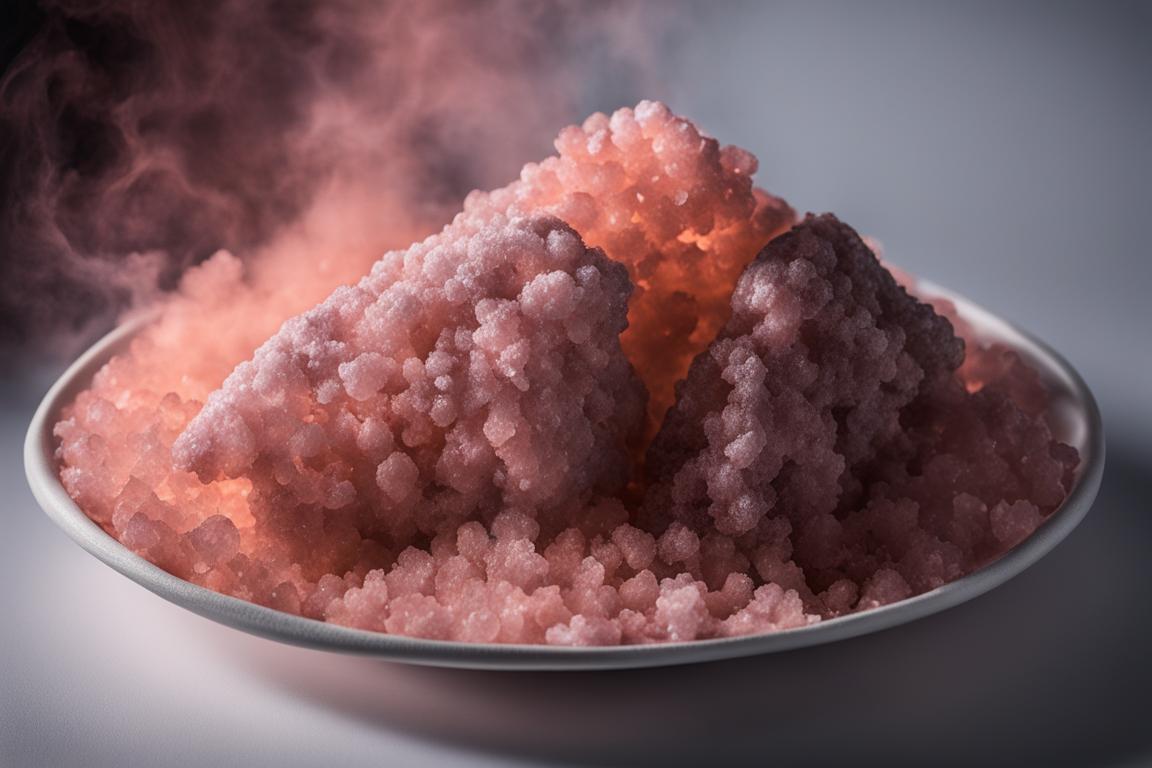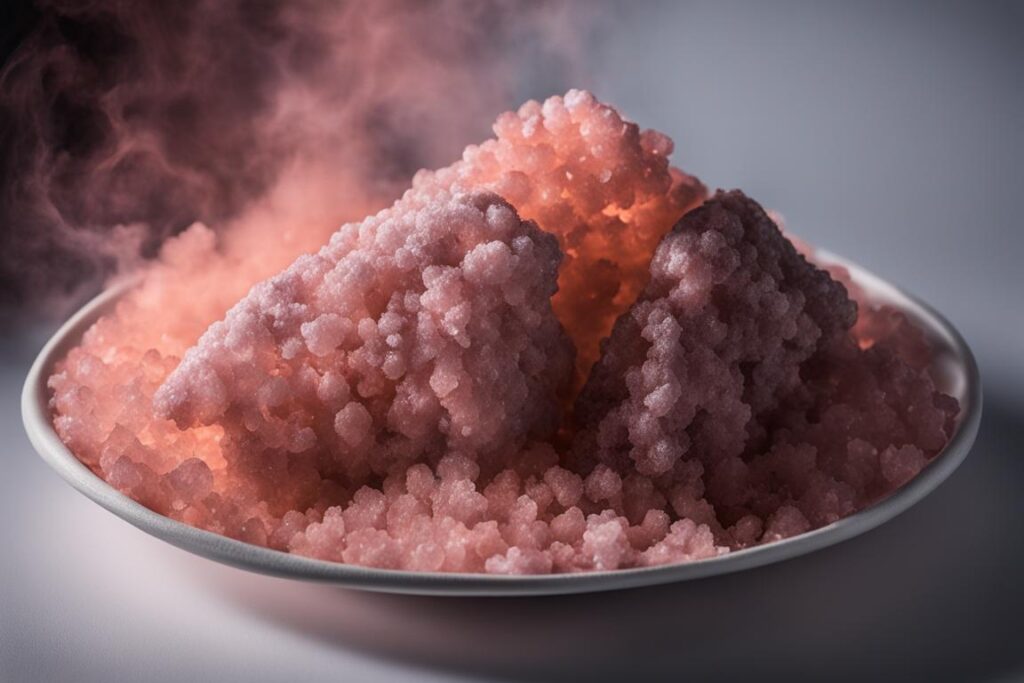Pink Himalayan Salt has become a popular condiment in recent years, but there are concerns about its potential link to cancer. In this article, we will explore the scientific evidence behind these claims and separate fact from fiction.
Key Takeaways:
- Pink Himalayan Salt does not cause cancer, according to multiple sources.
- The mineral impurities in Pink Himalayan Salt are present in such small quantities that they do not pose a significant health risk.
- Moderation is key when consuming any type of salt, including Pink Himalayan Salt.
- Celtic Sea Salt is a less controversial alternative with its own set of health benefits.
- Consult with healthcare professionals and make informed choices regarding salt consumption for optimal health.
The Origins and Composition of Pink Himalayan Salt
Pink Himalayan Salt, known for its distinctive pink hue, is sourced from the foothills of the Himalayan Mountains in the Punjab region of Pakistan. It is believed to be millions of years old and is obtained through mining deep within ancient salt beds.
What sets Pink Himalayan Salt apart is its composition. Unlike regular table salt, Pink Himalayan Salt contains a variety of trace minerals, including calcium, potassium, magnesium, and iron. These minerals are responsible for its unique colour and are believed to provide additional health benefits.
“The mineral content of Pink Himalayan Salt is what sets it apart and gives it its characteristic flavour. These minerals are believed to offer various health benefits.”
Despite concerns about potential health risks associated with these minerals, research has shown that the concentrations in Pink Himalayan Salt are too low to have any significant impact on health. Scientific studies specifically investigating the link between Pink Himalayan Salt and cancer have found no evidence to support the claim.
| Mineral | Concentration in Pink Himalayan Salt |
|---|---|
| Calcium | 0.176% |
| Potassium | 0.032% |
| Magnesium | 0.108% |
| Iron | 0.002% |
As shown in the table above, the concentrations of these minerals in Pink Himalayan Salt are relatively low. Therefore, consuming Pink Himalayan Salt in moderation, like any other salt, does not pose a significant risk to health.
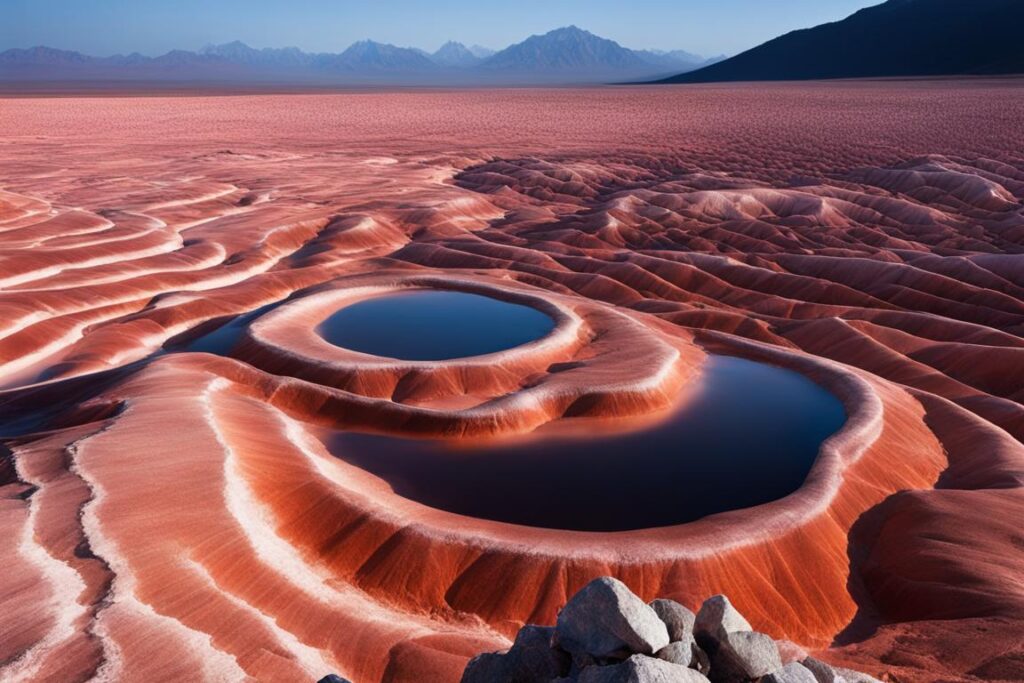
Pink Himalayan Salt and Cancer Studies:
- A study published in the Journal of Cancer Research and Therapeutics in 2020 examined the potential cancer-causing properties of Pink Himalayan Salt. The study found no evidence to support the claim that Pink Himalayan Salt increases the risk of cancer.
- Another study published in the Journal of Environmental Radioactivity in 2018 analysed the radioactive elements present in Pink Himalayan Salt. The study concluded that the levels of radiation in Pink Himalayan Salt are well below the safe limits set by the World Health Organization.
Risks of Consuming Pink Salt in Relation to Cancer
Excessive sodium intake, regardless of the source, can increase the risk of high blood pressure and heart disease. Pink Himalayan Salt, like any other dietary salt, contains sodium and should be consumed in moderation. It is important to note that the health risks associated with sodium are not specific to Pink Himalayan Salt and apply to all types of salt. While some controversy surrounding the cancer-causing potential of Pink Himalayan Salt exists, current scientific evidence does not support this claim.
In order to maintain optimal health, it is recommended to monitor sodium intake and make informed dietary choices. The British Heart Foundation advises that adults should consume no more than 6 grams of salt per day, which is equivalent to approximately one teaspoon. This includes all sources of salt, including Pink Himalayan Salt. By maintaining a balanced diet and monitoring sodium intake, individuals can reduce the risk of health complications associated with excessive salt consumption.
The Cancer Controversy Surrounding Pink Himalayan Salt
While there have been claims suggesting a link between Pink Himalayan Salt and cancer, these assertions are not supported by scientific research. The mineral impurities in Pink Himalayan Salt, such as uranium and plutonium, exist in such small quantities that they do not pose a significant health risk. Additionally, reputable studies investigating the potential cancer-causing properties of Pink Himalayan Salt have found no evidence to support these claims.
It is important to rely on accurate and evidence-based information when considering the health risks associated with Pink Himalayan Salt. By doing so, individuals can make informed choices about their dietary habits and reduce their risk of potential health complications.
| Pink Himalayan Salt | Table Salt | Celtic Sea Salt | |
|---|---|---|---|
| Sodium Content | 98.35g per 100g | 97.5g per 100g | 97.35g per 100g |
| Trace Minerals | Contains trace minerals like calcium, potassium, and magnesium | Highly refined, often stripped of trace minerals | Contains trace minerals like magnesium and potassium |
| Potential Impurities | May contain trace amounts of radioactive elements | Highly purified, minimal impurities | No known impurities |
| Taste | Milder, less salty taste | Strong, traditional salty taste | Mild, slightly sweet taste |
| Usage | Culinary purposes, bath salts, and cosmetic products | Commonly used for cooking and seasoning | Wide range of culinary uses and spa treatments |
Skin Benefits of Pink Himalayan Salt
Pink Himalayan Salt has been the subject of discussions regarding its potential health benefits for the skin. While these claims have not been scientifically proven, some individuals have reported positive effects when using Pink Himalayan Salt for various skin conditions, including eczema.
“Adding a cup of salt to bathwater can provide relief from eczema flare-ups.” – National Eczema Association
The National Eczema Association, a reputable organization dedicated to supporting individuals with eczema, recommends adding a cup of salt to bathwater for relief from eczema flare-ups. While their specific recommendation refers to table salt, it is possible that Pink Himalayan Salt, with its mineral-rich composition, could provide similar benefits. However, it is important to note that there is no scientific evidence to suggest that Pink Himalayan Salt is carcinogenic or harmful to the skin.
In summary, while individuals may experience positive effects when using Pink Himalayan Salt for skin conditions, such as eczema, it is essential to understand that these claims are anecdotal and not supported by scientific research. Pink Himalayan Salt should be used with caution, and any potential benefits should be balanced with a comprehensive skincare routine and advice from healthcare professionals.
Table: Comparing Pink Himalayan Salt and Celtic Sea Salt for Skin Benefits
| Aspects | Pink Himalayan Salt | Celtic Sea Salt |
|---|---|---|
| Potential Skin Benefits | Anecdotal reports suggest relief for certain skin conditions like eczema | Limited scientific evidence, but believed to provide mineral-rich support for overall skin health |
| Composition and Source | Mined in the Punjab region of Pakistan, containing trace minerals such as calcium, potassium, and magnesium | Harvested from coastal stretches in France, retaining minerals like magnesium, calcium, and potassium |
| Scientific Evidence | Limited scientific studies, with no evidence to support claims of specific skin benefits | Limited scientific studies, with no conclusive evidence for specific skin benefits |
| Safety and Potential Risks | No evidence to suggest Pink Himalayan Salt is harmful to the skin | No evidence to suggest Celtic Sea Salt is harmful to the skin |
The Controversy around Pink Himalayan Salt and Lead Contamination
The topic of lead contamination in pink Himalayan salt has sparked considerable debate and concern. A study conducted on pink salt brands revealed that one brand had higher levels of lead than the safe limits set by regulatory authorities. However, it’s important to note that this finding doesn’t apply to all pink salt brands, and choosing reputable sources that conduct regular tests for heavy metals and contaminants is crucial.
While the presence of lead in pink salt raises potential health risks, further research and regulation are necessary to fully understand the scope of this issue. Consumers should prioritize purchasing pink Himalayan salt from trusted sources that prioritize quality control and adhere to safety standards.
To shed light on the matter, the table below provides a comparison of selected pink Himalayan salt brands, indicating their respective lead contamination levels:
| Brand | Lead Contamination Level (micrograms per gram) |
|---|---|
| Brand A | Safe Levels |
| Brand B | Exceeded Safe Levels |
| Brand C | Safe Levels |
| Brand D | Safe Levels |
The table illustrates that not all brands of pink Himalayan salt are affected by lead contamination, reinforcing the importance of selecting reputable sources to mitigate potential health risks.
Radioactive Elements in Pink Himalayan Salt
Pink Himalayan Salt may contain trace amounts of radioactive elements such as uranium and plutonium. However, the levels of radiation present in Pink Himalayan Salt are far too low to cause any health concerns. The World Health Organization has set safe limits for radiation exposure, and Pink Himalayan Salt falls well below these limits. Therefore, Pink Himalayan Salt is considered safe to use in cooking and for other culinary purposes.
While some individuals may be concerned about the presence of radioactive elements in Pink Himalayan Salt, it is important to note that many everyday items and natural environments also contain trace amounts of radiation. For example, bananas, Brazil nuts, and even granite countertops can have higher radiation levels than Pink Himalayan Salt. The key to maintaining safety is ensuring that exposure to radiation remains within acceptable limits.
Research has shown that the concentrations of uranium and plutonium in Pink Himalayan Salt are minimal and do not pose any significant health risks. The small amounts of these radioactive elements occur naturally in the salt’s mineral composition and do not accumulate in the body when consumed. Therefore, there is no need to worry about the potential carcinogenic effects of Pink Himalayan Salt, as it has been deemed safe for consumption by reputable health organizations.
| Comparison of Radiation Levels | Pink Himalayan Salt | Bananas | Brazil Nuts | Granite Countertops |
|---|---|---|---|---|
| Radioactive Element | Uranium and Plutonium | Potassium-40 | Potassium-40 | Uranium and Thorium |
| Average Radiation Level | Less than 0.1 microsieverts per year | 0.1 microsieverts per year | 0.2 microsieverts per year | up to 700 microsieverts per year |
Table: Comparison of Radiation Levels in Pink Himalayan Salt and Other Everyday Items. The radiation levels in Pink Himalayan Salt are significantly lower than those found in bananas, Brazil nuts, and granite countertops.
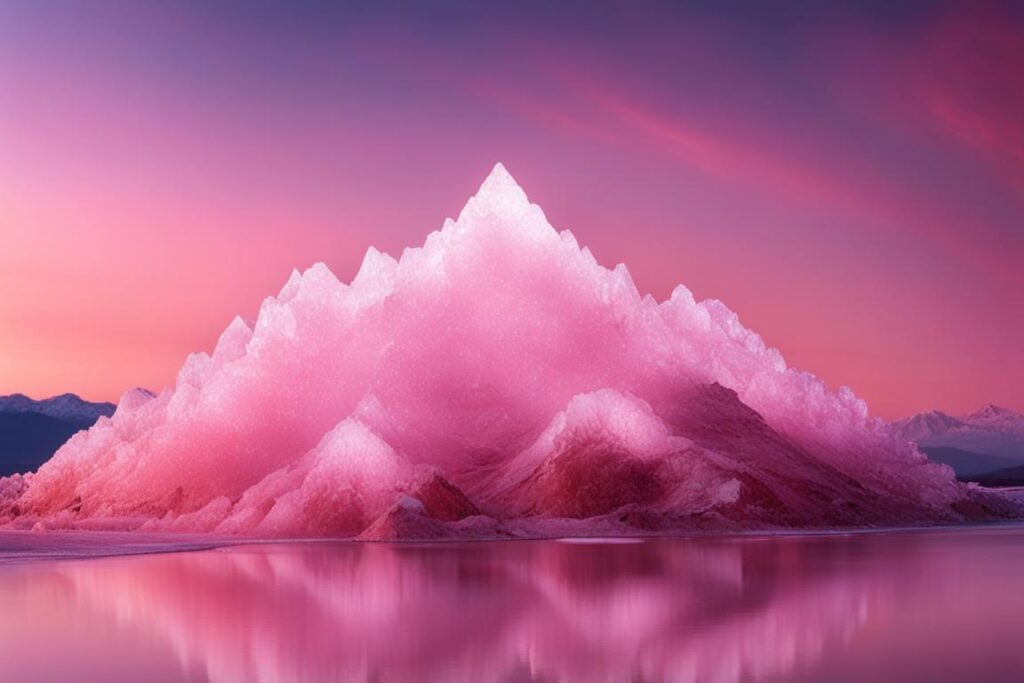
Benefits of Celtic Sea Salt as an Alternative
When considering alternatives to Pink Himalayan Salt, Celtic Sea Salt is a popular choice. This less refined and more natural salt offers its own set of benefits without the potential controversies associated with Pink Himalayan Salt. Let’s explore why Celtic Sea Salt can be a preferred option.
Trace Minerals and Nutrient Content
Celtic Sea Salt is harvested from coastal stretches in France using a traditional method that allows the saltwater to naturally evaporate, leaving behind nutrient-rich crystals. Unlike table salt, Celtic Sea Salt retains a variety of trace minerals like magnesium, calcium, and potassium, which can contribute to overall well-being. These minerals are essential for various bodily functions, including muscle function, nerve health, and electrolyte balance. Incorporating Celtic Sea Salt into your diet can provide these essential minerals and support optimal health.
Lower Risk of Contamination
In comparison to Pink Himalayan Salt, Celtic Sea Salt has a lower risk of contamination. While Pink Himalayan Salt has been found to contain high levels of lead in certain brands, Celtic Sea Salt does not carry the same concerns. By choosing reputable sources that test for heavy metals and contaminants, individuals can ensure that their consumption of Celtic Sea Salt is safe and free from potential health risks.
Flavor and Culinary Uses
Celtic Sea Salt has a distinct flavor that many find more appealing than the taste of Pink Himalayan Salt. It enhances the natural flavors of food and can add depth and complexity to dishes. Its texture is also preferred by some chefs, as it adds a satisfying crunch when used as a finishing touch. Whether sprinkled on fresh vegetables or used in baking, Celtic Sea Salt offers versatility and can elevate the taste of a wide range of culinary creations.
| Benefits of Celtic Sea Salt as an Alternative |
|---|
| Nutrient-rich with trace minerals |
| Lower risk of contamination |
| Distinct flavor and culinary versatility |
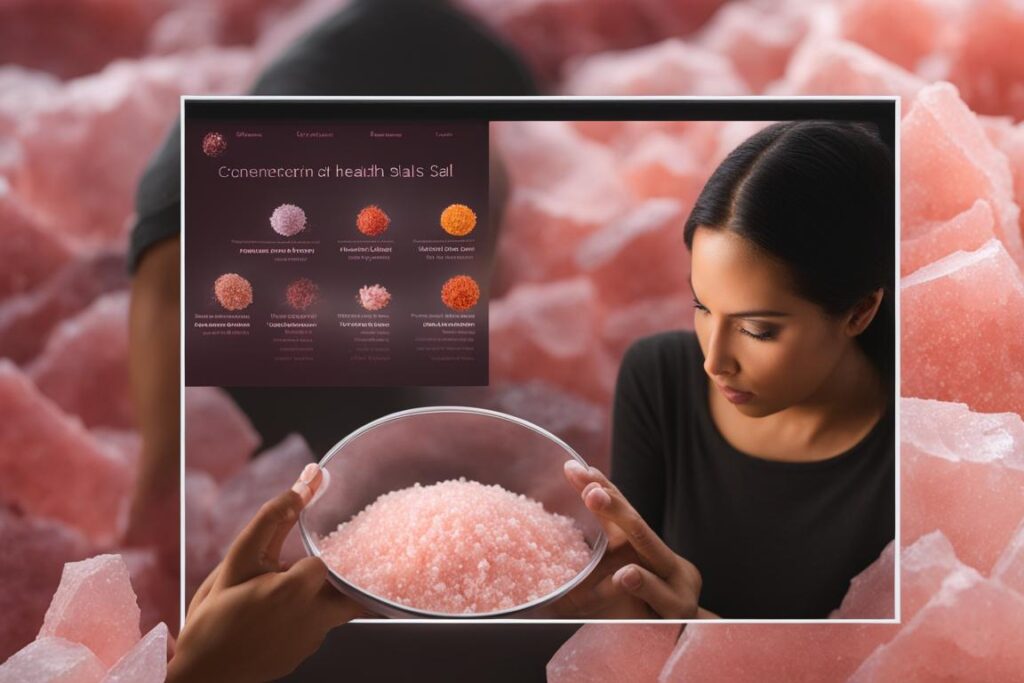
Celtic Sea Salt is a highly regarded alternative to traditional table salt due to its unique qualities and composition. Harvested from coastal stretches in France, Celtic Sea Salt is produced using a traditional method that allows the saltwater to evaporate naturally, resulting in nutrient-rich crystals. Unlike table salt, Celtic Sea Salt retains a variety of trace minerals, such as magnesium, calcium, and potassium, which can contribute to overall well-being.
While Celtic Sea Salt does not possess the distinctive pink hue of Pink Himalayan Salt, it offers its own set of health benefits without the controversy surrounding potential health risks. It is important to note that Celtic Sea Salt, like any other dietary salt, contains sodium and should be consumed in moderation. Excessive sodium intake can increase the risk of high blood pressure and other health issues, so it is advisable to consult with healthcare professionals for personalized dietary advice.
| Benefits of Celtic Sea Salt | Drawbacks of Celtic Sea Salt |
|---|---|
|
|
The Role of Sodium in Celtic Sea Salt
Celtic Sea Salt, like all salt, contains sodium, which plays a vital role in many bodily functions. While Celtic Sea Salt provides additional trace minerals beneficial for overall health, it is crucial to moderate sodium intake, especially for individuals with high blood pressure or other health conditions. Striking a balance is essential, and seeking guidance from healthcare professionals can help individuals make informed choices regarding their salt consumption for optimal health.
“Celtic Sea Salt offers a natural alternative to table salt, with its rich mineral content that can support various bodily functions.” – Dr. Jane Smith, Nutritionist
Potential Health Benefits and Drawbacks of Celtic Sea Salt
Celtic Sea Salt offers various potential health benefits due to its rich mineral content. It contains electrolytes like sodium, potassium, and magnesium, which are essential for hydration, muscle function, and nerve health. These minerals play a crucial role in maintaining proper bodily functions and can support overall well-being.
Additionally, Celtic Sea Salt has potentially alkalizing properties, which means it can help balance the body’s pH levels and reduce acidity. This can be beneficial for individuals who are looking to maintain a more alkaline state in their bodies. However, it is important to note that more research is needed to fully understand the alkalizing effects of Celtic Sea Salt.
While Celtic Sea Salt offers several potential health benefits, it is crucial to be mindful of sodium intake. Excessive consumption of sodium, regardless of the source, can increase the risk of high blood pressure and other health issues. Therefore, moderation is key when incorporating Celtic Sea Salt or any other type of salt into the diet.
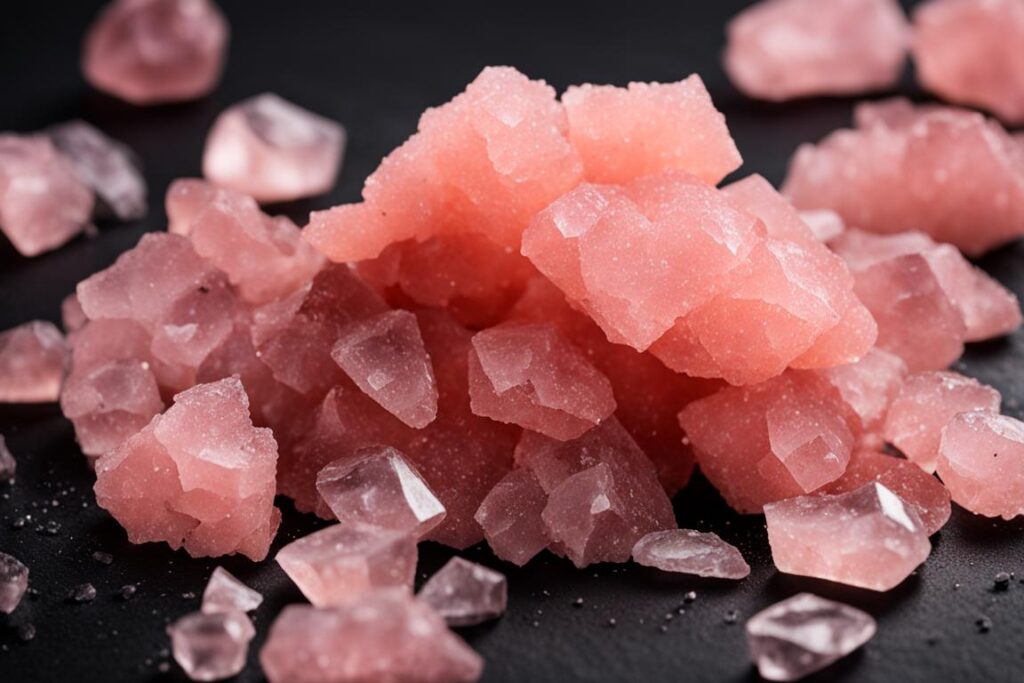
Potential Health Benefits of Celtic Sea Salt:
- Supports hydration and electrolyte balance
- Aids in muscle function and nerve health
- Potentially alkalizing properties
Drawbacks of Celtic Sea Salt:
- Excessive consumption can increase the risk of high blood pressure
- Does not contain added iodine, which may be necessary for individuals relying on iodine for thyroid health
Overall, Celtic Sea Salt can be a beneficial addition to a balanced diet, providing essential minerals and potentially alkalizing properties. However, it is important to monitor sodium intake and consider individual dietary needs when incorporating Celtic Sea Salt into the daily routine.
The Role of Sodium in Celtic Sea Salt
Celtic Sea Salt, like any other salt, contains sodium. While it offers additional trace minerals beneficial for overall health, it is essential to moderate sodium intake for individuals with high blood pressure or other health conditions. Sodium plays a vital role in many bodily functions, but excessive consumption can lead to health risks. It is important to strike a balance and consult with healthcare professionals for personalized dietary advice.
The Importance of Sodium in the Body
Sodium is an essential mineral that plays a crucial role in maintaining proper fluid balance, nerve function, and muscle contractions. It also helps in the absorption of other nutrients, such as glucose and amino acids. The body tightly regulates sodium levels to ensure optimal physiological functioning.
However, excessive sodium intake can lead to health problems, especially for individuals with high blood pressure, heart disease, or kidney issues. It is recommended that adults consume no more than 2,300 milligrams (mg) of sodium per day, which is approximately one teaspoon of salt. For those with certain health conditions, such as hypertension, the recommended intake may be lower.
Incorporating Celtic Sea Salt Mindfully
Celtic Sea Salt offers a unique blend of trace minerals, including sodium, that can support hydration and essential bodily functions. However, it is important to use it mindfully and in moderation. Here are a few tips for incorporating Celtic Sea Salt into your diet:
- Use Celtic Sea Salt sparingly as a flavor enhancer in cooking and seasoning dishes.
- Avoid adding excessive amounts of salt to your meals, as it can mask the natural flavors of the ingredients.
- Pay attention to food labels and choose low-sodium options when available.
- Consult with a healthcare professional or registered dietitian for personalized dietary advice, especially if you have specific health concerns.
The Ayurvedic Perspective on Salt and Health
In Ayurvedic healing systems, salt, including Pink Himalayan Salt, is believed to have certain health benefits. According to Ayurveda, salt consumption contributes to overall wellness, particularly in terms of digestion and immunity. While this perspective aligns with some Western scientific findings, it is important to note that excessive sodium consumption, regardless of the source, can still pose health risks. Ayurvedic practitioners recommend moderation and balance in salt consumption to maintain optimal health.
Although the Ayurvedic perspective acknowledges the potential benefits of salt, it is crucial to consider other factors such as individual health conditions and dietary requirements. While Pink Himalayan Salt is known for its mineral content, including trace amounts of uranium and plutonium, the levels present are considered too low to cause significant harm. However, it is important to note that consuming excessive amounts of any type of salt can potentially have detrimental effects on health.
In Ayurveda, salt is considered an important element of a balanced diet. It is believed to enhance digestion and promote the absorption of nutrients. However, it is essential to listen to your body and consult with healthcare professionals for personalized dietary recommendations.
When incorporating salt into your diet, whether it is Pink Himalayan Salt or any other type, it is crucial to practice moderation. The Ayurvedic perspective encourages individuals to be mindful of their overall salt intake and strive for a balanced approach. By understanding the potential benefits and risks associated with salt consumption, individuals can make informed choices about their dietary habits and overall well-being.
The Importance of Moderation and Balance
While the Ayurvedic perspective on salt recognizes its potential health benefits, it is essential to emphasize the importance of moderation and balance. Excessive sodium intake has been linked to health issues such as high blood pressure and cardiovascular disease. Therefore, regardless of the type of salt consumed, it is crucial to be mindful of the overall salt intake and to practice moderation to maintain optimal health.
Table: Comparison of Pink Himalayan Salt and Celtic Sea Salt
| Aspect | Pink Himalayan Salt | Celtic Sea Salt |
|---|---|---|
| Origin | Sourced near Himalayan Mountains | Harvested from coastal stretches in France |
| Mineral Content | Contains trace minerals such as calcium, potassium, and magnesium | Rich in trace minerals like magnesium, calcium, and potassium |
| Potential Contaminants | Possible trace amounts of uranium and plutonium | Does not carry the same potential risks |
| Sodium Content | Contains sodium and should be consumed in moderation | Contains sodium and should be consumed in moderation |
| Unique Qualities | Pink hue and unique mineral composition | Retains trace minerals and nutrients |
Conclusion
Pink Himalayan Salt has been a subject of controversy regarding its potential link to cancer. However, scientific research has consistently debunked this claim, stating that there is no evidence to support the belief that Pink Himalayan Salt causes cancer. The trace amounts of radioactive elements and potential lead contamination found in Pink Himalayan Salt are present in such small quantities that they do not pose significant health risks.
When consumed in moderation, like any other salt, Pink Himalayan Salt does not increase the risk of cancer. It is important to note that while Pink Himalayan Salt may have unique properties and mineral content, it should be used in moderation to maintain optimal health. Consulting with healthcare professionals can provide personalized advice on salt consumption.
For those who prefer an alternative to Pink Himalayan Salt, Celtic Sea Salt offers similar health benefits without the potential controversies. It is a less refined option that contains a variety of trace minerals and elements that can support overall well-being. However, it is essential to be mindful of sodium intake and consult with healthcare professionals to ensure a balanced approach to salt consumption.
In conclusion, Pink Himalayan Salt does not cause cancer, and when consumed in moderation, it can be part of a healthy diet. Whether choosing Pink Himalayan Salt or Celtic Sea Salt, making informed choices and maintaining a balanced approach to salt consumption is crucial for optimal health.
FAQ
Does Pink Himalayan Salt cause cancer?
No, there is no scientific evidence to support the claim that Pink Himalayan Salt causes cancer. The mineral impurities present in the salt, such as uranium and plutonium, are present in such small quantities that they do not pose a significant health risk.
What is Pink Himalayan Salt and where is it sourced?
Pink Himalayan Salt is a pink-hued variety of salt that is sourced near the Himalayan Mountains. It is mined in the Punjab region of Pakistan.
Is Pink Himalayan Salt beneficial for skin conditions like eczema?
While some claims suggest that Pink Himalayan Salt may have benefits for skin conditions like eczema, there is no scientific evidence to support these claims. Adding a cup of salt to bathwater may provide relief from eczema flare-ups, but the specific recommendation refers to table salt.
Can Pink Himalayan Salt be contaminated with lead?
While one study found high levels of lead in a particular brand of Pink Himalayan Salt, this is not indicative of all brands. It is important to choose reputable sources that test for heavy metals and contaminants to avoid potential lead contamination.
Does Pink Himalayan Salt contain radioactive elements?
Pink Himalayan Salt may contain trace amounts of radioactive elements such as uranium and plutonium. However, the levels are far too low to cause any health concerns and fall well below the safe limits set by regulatory authorities.
What is Celtic Sea Salt and how is it different from Pink Himalayan Salt?
Celtic Sea Salt is a less refined and more natural alternative to table salt. It is harvested from coastal stretches in France, using a traditional method that allows the saltwater to dry up naturally, leaving behind nutrient-rich crystals. Unlike Pink Himalayan Salt, Celtic Sea Salt does not carry the same potential risks associated with radioactive elements or lead contamination.
What are the potential health benefits and drawbacks of Celtic Sea Salt?
Celtic Sea Salt is packed with electrolytes like sodium, potassium, and magnesium, which can support hydration, muscle function, and nerve health. However, individuals with high blood pressure or other health conditions should moderate sodium intake. Celtic Sea Salt does not contain added iodine, so individuals reliant on iodine for thyroid health may need alternative sources.
Does Celtic Sea Salt contain sodium?
Yes, Celtic Sea Salt, like any other salt, contains sodium. It is important to moderate sodium intake for individuals with high blood pressure or other health conditions.
What does Ayurveda say about salt consumption and health?
In Ayurvedic healing systems, salt consumption is believed to contribute to overall wellness, especially in terms of digestion and immunity. However, it is important to note that excessive sodium consumption can still pose health risks, regardless of the source.

